Have you tried Korean food? If not, you’re in for a treat!
And if so, then you’re going to love what we have in-store today.
Korean food is healthy and tasty, with lots of different varieties for every season. And by trying the food, you’ll also be experiencing the culture.
Whether you’re in a Korean BBQ restaurant in your current city or you’ve made the trip and are exploring the authentic street food of Seoul, we’ve compiled the top Korean food lineup you should be on the lookout for.
Let’s get to it!
Contents
Different types of Korean food
There’s a wide variety of Korean food, and you might have tried some of them before. Don’t be alarmed if some of these foods are like nothing you’ve ever seen before – Korean cuisine is known for incorporating exotic complementary flavors and often incorporates bright colors and funky textures.
Each of the foods on our list has something unique that sets it apart from the rest, so try as many as possible to get an accurate taste of Korea!
We’ve included the names of food in Hangul (Korean alphabet) so that you can find them in Korea more easily. If you can’t read Hangul, it is possible to learn in just ninety minutes using fun associations and stories. It will be helpful when reading menus in Hangul. If you want to learn more terms for food in Korean, we have them in this article.
Onto our list of delicious Korean food!
Popular Korean Side Dishes
Korean side dishes are called 반찬 (banchan) in Korean. This is the collective term for the small side dishes served with the main dish in a typical Korean meal.
Kimchi (김치 | gimchi)
Kimchi is a tried and true staple that has been around for over two thousand years in various Korean food. It’s made through salting and fermenting to create a distinctively spicy flavor, and it’s the best thing that’s ever happened to cabbage. (Seriously. What other food has made you excited about cabbage?)
Kimchi is one of the most versatile Korean side dishes out there. While classic, cabbage kimchi is the original favorite and is available pretty much everywhere in Korea, different types of vegetables can be salted and fermented to create different tastes (with some being spicier than others!).
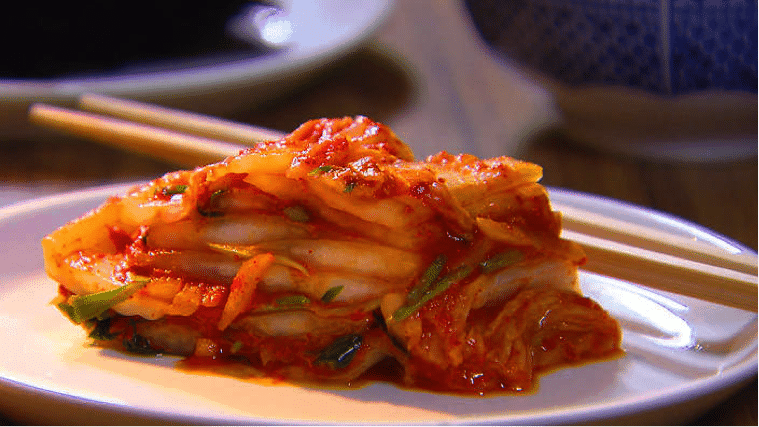
If you’re looking for a way to spice up an otherwise bland meal, incorporate one of the many types of kimchi! It’s a classic crowd favorite for a reason, and you won’t be disappointed. Note that kimchi may be spelled as “kimchi” or “gimchi.” Kimchi is the more common way, while gimchi is the newer spelling. Kimchi in Hangul is 김치.
There are many different varieties of kimchi, from plain to extra spicy. There are also many types of ways to make Kimchi made from different types of ingredients. Each kimchi maker has his or her own style. Some people use green cabbages to make Yangbaechu Kimchi or Green Cabbage Kimchi.
This spicy banchan is usually served as a side dish to many Korean barbeque combos.
Tofu kimchi (두부 김치 | dubu gimchi)
Dubukimchi is a Korean food featuring three distinct, different flavors – tofu, pork, and kimchi. While tofu isn’t necessarily exciting on its own, it pairs wonderfully with the stir-fried pork and kimchi in this dish because the intense flavor of the latter two balances out the subtle flavors of the tofu.
This Korean food is also jam-packed with protein from the tofu and the pork as well as nutrients from the fermented kimchi – you’ll be making your body happy as well as your taste buds!
This food is a common banchan that is served along with Korean Barbeque. Order a plate of dubukimchi the next time you want a solid, satisfying entrée full of flavorful elements that are great on their own and as a trio. You won’t be disappointed!
Dotorimuk (도토리묵)
Dotorimuk is a curious Korean food – made from acorn starch solidified into cold, dense jello.
Dotorimuk is a similar fish to tofu in that it is full of protein and vegan-friendly food. It is also versatile in its flavor in the same way that tofu is – dotorimuk does not have a distinct flavor of its own, so it can be served with a variety of flavors and textures to enhance or bring together a meal because it takes on the flavor of what it is prepared with.
Dotorimuk is frequently served as a banchan side dish and can be paired with soy sauce to make the flavor more exciting. Take a walk on the wild side and order a side of dotorimuk the next time you see it on a menu!
Korean instant noodles (라면 | ramyeon)
Instant noodles are a type of food that has unarguably transcended cultural barriers. While popularized in Korea, they’ve become a kitchen must-have all over the world.
Short on time? No worries! These noodles only require a couple of steps and are ready as quickly as the water boils – just follow the directions on the back of the packet. Short on money? No problem. Korean instant noodles are notorious for their less-than-intimidating price tag. You can probably pick up a pack for less than the change that you have in your pocket right now.
While basic Korean instant noodles are relatively uncomplicated, there’s plenty you can do in the kitchen to spice up your noodle combo and make it a little more interesting. Try adding boiled egg, tuna, tofu, or other meat such as beef, slices of pork belly, or chicken – these Korean favorites can help a boring meal transcend to something sublime!
You may also want to pair your cup of noodles with kimchi and mix it with cheese. Adding cheese is one of the best ways to lessen the spicy flavor of your noodles. There are many different brands and varieties of Korean instant noodles. Some are spicy, and others are milder. Check them all out and see which one is your style.
Whether you’re treating instant noodles as an appetizer or your main course, you can’t go wrong with incorporating this classic staple into your meal. Instant noodles have become so much popular in Korea that there are even simple but unique ways you can eat them that will really impress your Korean friends!
Soy sauce crab (간장게장 | ganjanggejang)
As far as Korean seafood dishes go, ganjang gejang (crab prepared by soaking in soy sauce before serving) is a gem that’s not for the faint of heart. Ganjang gejang is a powerful South Korean dish served cold, and it’s notorious for its bitter aftertaste that tends to linger long after you’ve finished eating.
Though this Korean cuisine is on the intense end of the spectrum, it’s also insanely popular – the food’s nickname is “rice thief” because the sauce is so tasty that it’s hard to resist piling extra rice onto your plate to soak it all up once the crab is gone!
The next time you’re out and see ganjang gejang on the menu at your favorite Korean restaurant, consider ordering it so you can know what all the fuss is about – you may find that you have a new favorite meal! If you’re unsure how to do that, here’s a guide on how you can order in a Korean restaurant.
Yukhoe (육회)
Raw slices of marinated beef may sound intimidating at first – fear not, foodies. This Korean cuisine is perfectly safe and is best known as steak tartare in other countries, which is considered a delicacy in most places and can be found in fine dining establishments.
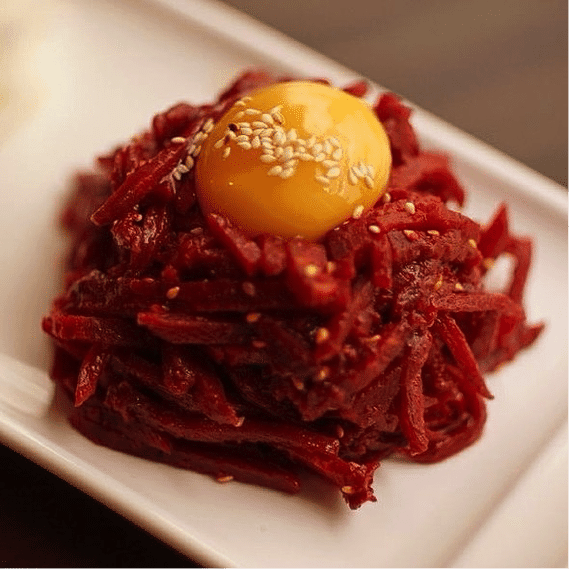
This Korean food can either be served as a standalone meal or as a topping on another dish. If it’s your first time, I recommend ordering it as a standalone food so you can appreciate the flavor (and the experience) without distraction from other strong flavors.
Be warned, however – while tasty and tender, the meal’s price can be a bit higher than average, as chefs choose the best selections of marinated beef to star in the Korean favorite. If you love meat and don’t mind paying a little bit extra to get a meal you know you’ll love, yukhoe may be a delicacy for you!
Doenjang (된장)
I’m sure that you’re familiar with soy sauce. It is a staple in many Asian cuisines, and it complements anything due to its savory nature. However, did you know that soy sauce is a byproduct of doenjang? Doenjang is a paste derived from fermented soybeans – it boasts a strong taste and a not-so-appealing color, so it’s not quite as popular as soy sauce on its own.
However, doenjang is a beloved Korean cuisine that can spice up simple dishes in a way that other spices can’t if you’re looking to add a little more character than soy sauce can provide on its own. Give it a try in bibimbap – the taste may be something you’ve never experienced, and set a new spice standard for your meals!
Haemul Pajeon (해물파전)
How do you like your pancakes? Warm, with maple syrup? How about full of seafood? This South Korean meal turns the basic pancake concept on its head. Haemul Pajeon is a crunchy fried pancake stuffed to the brim with different vegetables and seafood ingredients, resulting in a satisfying, savory meal.
You may also see this food nicknamed “Korean pizza” since it looks like an actual pizza.
These pancakes are said to go well with rice wine – pour yourself a glass and enjoy this intricate South Korean meal.
Bibimbap (비빔밥)
If you’re on your lunch break and are on a time crunch, bibimbap may be the perfect food to leave you satisfied and get you back to the office on time. A Korean favorite takes multiple food groups and combines them in one lunch bowl to make sure you’re getting a balanced lunch in a simplified form.
Bibimbap is mixed rice, vegetables, meat, and a fried egg for a balanced flavor, so it also hits all of your major food groups for the day. Sesame oil and chili paste are added to the dish for a little extra flavor to really bring the meal together and add a spicy element that makes it so popular.
While bibimbap used to be a meal meant for Korean royalty, it’s now accessible all over Korea and a crowd-pleaser. This mixed rice dish can be served as the main food or along with Korean Barbeque. Get your fix of vegetables and give bibimbap a shot on your next lunch break – you’ll be glad you did!
Oimuchim (오이무침)
While most of the dishes on this list can be considered a full meal (or close to one), oimuchim is the answer if you’re in search of a light summertime dish but can’t bring yourself to eat anything too heavy or filling. Most commonly eaten as a snack or a side dish, oimuchim is a cut-up cucumber marinated in vinegar and red chili flakes.
Cucumber is arguably one of the best summertime vegetables due to its high water content and crisp texture. The vinegar and red chili flakes combine to bring out the subtle flavors of the cucumber. The chili flakes also add a spice that makes the dish interesting (because, face it, although it’s great, cucumber isn’t super interesting on its own).
Order a side of oimuchim as a standalone refresher or as a complementary side dish to one of the larger dishes on this list!
Golbaengi Muchim (골뱅이무침)
Don’t knock this food before you try it! While “snail” isn’t a word that makes most people’s mouths water (unless you’re an escargot fan), sea snail salad is a traditional Korean dish that pairs perfectly with an alcoholic beverage – something about the taste of snail, the spicy flavor and the bitter taste of alcohol really complement each other.
Had a long week at work? Look no further! Relax with a beer (or two) and dive into some sea snail salad for a spicy treat to take an edge off.
Jjolmyeon (쫄면)
Jjolmyeon is basically a noodle dish, but with a fresh approach to more traditional noodle dishes – rather than being served hot, this noodle dish is served cold and chewy. The dish’s temperature and the crunchy vegetables make it a refreshing treat, so this is a great food to enjoy during the sweltering Korean summer.
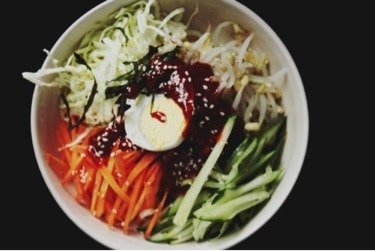
Extra thick noodles are combined with spicy chili paste and a variety of fresh vegetables, and they all come together to form something magical. Dig into a bowl of jjolmyeon for a refreshing (yet spicy!) snack, and you’ll quickly understand all of the hype.
Gyeranjjim (계란찜)
Gyeranjjim is often served as an appetizer at Korean BBQ restaurants. You’ll see it together with some of the spicier options on this list to bring the meal together – and give your mouth a break from all of the spice! An egg is beaten, steamed, and baked into a moist, dense cake, resulting in a dish that is mild in flavor and soft to the touch.
Served plain or with vegetables and sesame seeds on top to bring out the slightly salty flavor, give this Korean dish a try the next time your eyes are watering from a spicy dish! Something about the egg’s mild taste acts as a neutralizer for a lot of spice, so if you’re in over your head with a dish’s spice factor, this dish will help you cool off.
Best Korean Soups
Next up are the different Korean soups or stews! There are several types of soups in Korea, some of which are cooked for specific occasions. These are also usually served to someone feeling under the weather (or hungover), and they definitely help!
Kimchi stew (김치찌개 | gimchijjigae)
Kimchi pairs well with almost everything, so it’s only natural to make its unique flavor the focus of a stew! Kimchi-jjigae is one of the most popular South Korean stew dishes out there, and the popularity of this stew is no surprise when you consider how popular kimchi is as a standalone food.
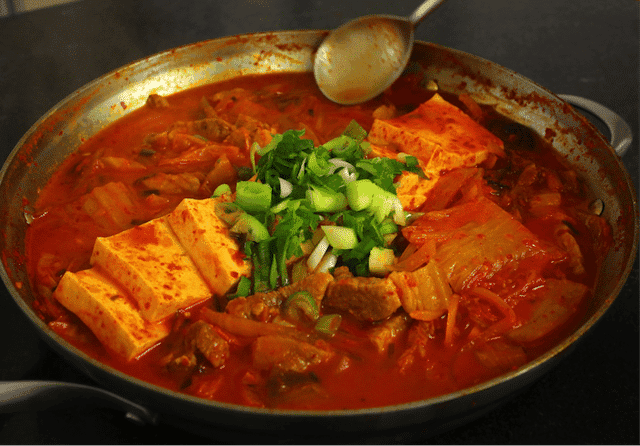
While the vegetables and meat that the stew incorporates can change from restaurant to restaurant depending on preference and availability, the most popular versions of kimchi stew include tender, savory slices of pork belly, scallions, and a whole lot of kimchi. You’ll often get a bowl of rice with it as well.
You can mix and match with the protein and vegetables that sound best to you, so this warm, filling stew can be whatever you want it to be! Try a bowl of kimchi-jjigae the next time you want something that will fill you up and provide some intense flavor profiles at the same time.
Ox Bone Soup (설렁탕 | Seolleongtang)
Don’t let the name scare you! Ox bone soup is a delicious Korean favorite that proves that simple food can be better than more complex meals if it’s done well. Ox bone soup only has a few ingredients – ox bones (meat cooked with the bones), noodles, and a couple of sparse scallions float around in a milky-white colored broth for an extra kick.
This is the perfect meal for a cold day, or if you’re feeling a little under the weather – think of it as a Korean rendition of the classic chicken noodle soup cold cure. Warm, satisfying, and simple, give ox bone soup a try the next time you’re looking for a classic cold-weather meal!
Galbitang (갈비탕)
Galbitang, a Korean soup made from simmering beef ribs, is the perfect dish if you’re suffering from a cold or allergies that have your nose and sinuses clogged up.
There’s nothing worse than not being able to breathe through your nose while you’re sick — pressure starts to build in your head, you have tissues on hand all day, and the post-nasal drip never seems to end! The next time you find yourself stuffed up, make yourself a bowl of galbitang, and you’ll clear your nose right up!
Galbitang is prepared by simmering beef over a low to medium temperature until the meat is so tender it literally falls off the bones. There are different variations of this soup, but the one you should prepare yourself also incorporates spicy hot peppers, which help open up the sinuses and get you breathing again.
This Korean food is also ideal for when you’re feeling under the weather because it’s hearty and full of nutrients, so you’ll make sure that your body has the energy and fuel it needs to fight off your illness and feel better as soon as possible.
Hangover Stew (해장국 | haejangguk)
The Korean drinking scene is no joke and not for the faint of heart – with a ton of interesting Korean alcohols like soju available at most bars, restaurants, and grocery stores, it should be no surprise that this food is affectionately called “hangover stew” and is a staple throughout Korea.
Served with a side of rice, this stew is made with congealed chunks of ox blood, and something about the sodium content helps immensely with waking your brain up when you’ve done some damage the night before.
Don’t let the blood scare you! If you’re spending time in Korea soon, you’ll probably spend some time enjoying the great bars scattered throughout the country, so this Korean food will definitely come in handy. Give hangover stew a try the next time you need to roll out of bed bright and early after a night of drinking, and you’ll see why the Koreans can’t do without it.
Army Stew (부대찌개 | budaejjigae)
The origin story behind this warm, satisfying stew is as interesting as its name! Army stew soared in popularity immediately after the Korean War, when times were tough, and the meat was expensive and hard to come by.
This Korean stew is filled with pantry staples like spam, American cheese, and instant noodles – plus a side of rice – all foods that were easily found at an army base in Seoul and widely available to the public.
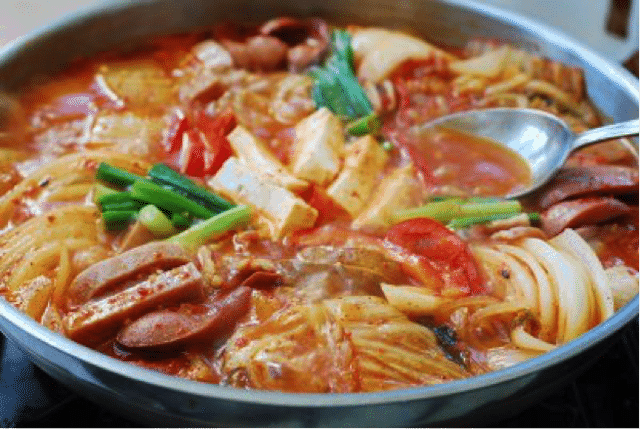
The best part about Korean Army Stew is that you can mix and match ingredients based on what you have in your pantry or fridge at any given time, so there’s no need to run out to the store to pick up specific additional ingredients – how convenient is that?
Give Army Stew a try the next time you REALLY don’t feel like trekking to the grocery store before cooking dinner, and you may be surprised at what you come up with!
Haemultang (해물탕)
Hamaeltang is a “live seafood soup,” but perhaps not in the way you are thinking – while the seafood is initially live, it is cooked in a scalding soup before it is served, so the seafood isn’t technically live when you’re eating it. That being said, seafood doesn’t get much fresher than hamultang!
This Korean soup is made with various spicy pastes and vegetables that give it a unique flavor and make it a favorite at Korean restaurants. Give a bowl of hamultang a try the next time you’re in the mood for seafood – after one bowl, you’ll be hooked!
Naengmyeon (냉면)
Naengmyeon literally translates to “cold noodles,” and it’s exactly what it sounds like! This popular summer Korean food is made of thin, long noodles made from buckwheat and vegetables like potato and sweet potato. This buckwheat noodle dish is served with a zesty stock, and sliced cucumber, pear, and radish are often added for additional flavor and crunch.
Don’t let the chilled part fool you — the broth of Naengmyeon is made from chilled beef or chicken stock, so it’s a hearty dish that will fill you up. This is definitely one of the more nutritious meals you’ll find in Korea due to the broth’s added vegetables and protein.
The next time you’re out for a fun lunch with friends (especially during the summer), give naengmyeon and see why it’s such a classic! You’ll be instantly refreshed, and it will give you energy for the rest of the day.
Mak-guksu (막국수)
Mak-guksu is another chilled broth and is made of Korean buckwheat noodles. Although customer’s preferences might vary, Mak-guksu is often very spicy because of the pepper paste sauce that is made with it. It’s best served with a boiled egg on top.
Kimchimariguksu (김치말이국수)
As you’re most likely already aware, kimchi is wildly popular throughout Korea and around the world. It’s difficult to find a menu without a dish that features kimchi in Korea due to its incredible versatility and intense taste profile. It’ll come as no surprise, then, that one of the most popular Korean summertime dishes is a celebration of kimchi!
Kimchimariguksu is a dish that incorporates cold noodles and an iced mixture of broths made from kimchi and meat. The result is a delicious flavor that marries the saltiness of the kimchi with the rich, savory notes of the meat, and the fact that it’s served cold makes the flavors that much more intense.
Kimchimariguksu will keep you cool, but your mouth will be feeling the heat from the spiciness of the kimchi. This dish is a great way to get your spice fix in the summer because the broth’s temperature will help you endure the spice without sweating up a storm.
Dalkalguksu (닭$칼국수)
Dalkkalguksu is a classic Korean take on chicken noodle soup. Like samgyetang, dalkkalguksu features chicken that has been seasoned to perfection in a hot, savory broth, served with hearty noodles. Most variations of dalkkalguksu feature zucchini and green onions tossed with vinegar, brightening up the dish and making it an all-time favorite.
Although dalkkalguksu isn’t a chilled dish, it’s popular for the same reason that samgyetang is popular: dalkkalguksu is meant to help relieve the negative effects of sweating summer fatigue by nourishing you and getting you back in tip-top shape. Order this crowd-pleaser after your next day in the sun, and you’ll see why Korean diners say this dish helps them survive the summer!
Soft tofu stew (순두부찌게 | sundubujjige)
If you’re looking for the perfect snack on a chilly, rainy winter day, look no further! Soft tofu stew is amazing for a couple of different reasons.
First, it combines distinct but very complementary flavors that make some magic happen in your mouth: the combination of silky soft tofu, kimchi broth, egg, and seafood is a force to be reckoned with. The contrast in texture between the seafood, tofu, and egg is amusing.
Second, this is a great Korean dish if you’re looking for a protein fix. Between the egg, the tofu, and the seafood, you have three different types of protein coming together to fill you up and leave you satisfied. Make some soft tofu stew the next time you need to warm yourself up!
Make sure to make some steamed rice to enjoy with it – you can use the rice to soak up the last few spoonfuls of the soup when you get to the bottom of the bowl. Look for this Korean food served alongside many different types of Korean BBQ.
Mandutguk (만둣국) & Tteokguk (떡국 )
Similar to porridge being popular because of how warm and filling it is, these two soups are popular go-to winter meals because they’ll warm you right up.
As if the warm soup isn’t amazing enough when it’s cold outside, there’s more! mandutguk contains dumplings, whereas tteokguk is full of rice cakes. If you can’t decide between the two, then you can sit on the fence and order 떡만둣국 (tteongmandutguk). It has both dumplings and rice cakes in it, so knock yourself out!
Samgyetang (삼계탕)
What better way to make yourself feel better when you’re suffering from a stuffy nose and fever than a steaming hot bowl of chicken soup? Samgyetang is a bowl of Korean chicken soup, but don’t be fooled — this isn’t the chicken noodle soup you’re used to eating when you’re sick.
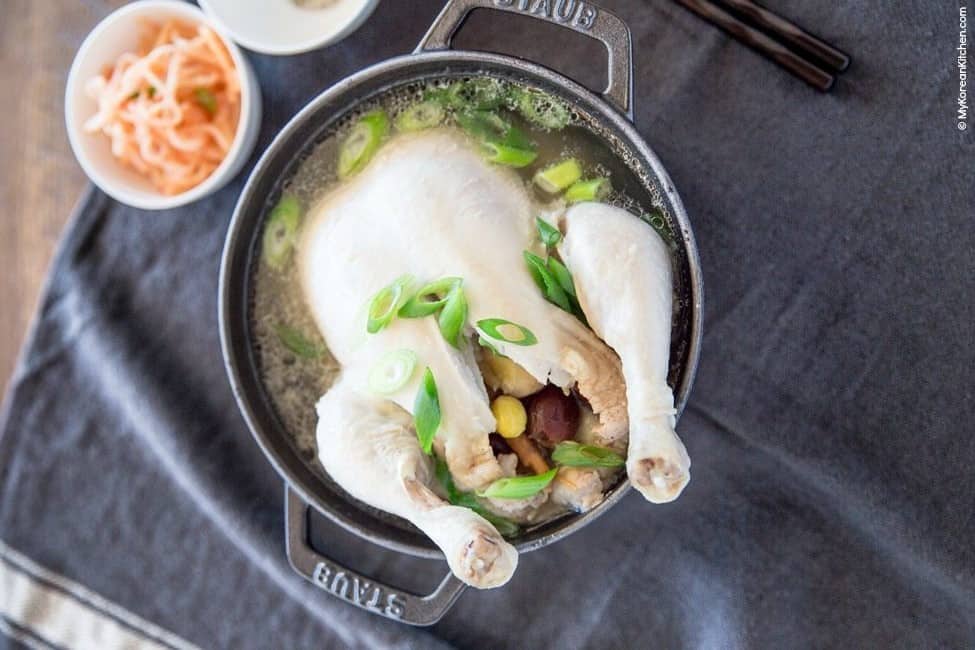
Samgyetang is made by stuffing a whole chicken with garlic, ginseng, and rice and bringing the dish to a boil until the broth is infused with the chicken’s flavors and the chicken is cooked through. When served, samgyetang is presented in a bowl with the whole chicken intact floating in the broth, and you’re meant to split open the chicken to get to the delicious flavors inside.
While not traditional chicken noodle soup, samgyetang is a dish consumed in Korea for its medicinal properties — it’s believed to help the body fight fire with fire, whether that be fighting the heat of a scalding summer day or fighting the heat of a fever.
Instead of eating cold food to cool yourself down the next time you’re feeling feverish, try a piping hot bowl of this ginseng chicken soup for some much-needed relief!
Korean BBQ
Check out these amazing meat dishes that will surely make your mouth water.
Galbi (갈비)
If you’ve been to a Korean BBQ restaurant recently, the chances are that you or somebody at your table decided to go with galbi.
Galbi literally translates to “rib,” and if not specified, the food can be centered around one of many types of meat depending on your preference (pork, chicken, or beef more often than not). Strips of meat are prepared with soy sauce, sugar, and garlic before being cooked over an open fire to ensure the outside is seared while the inside remains tender.
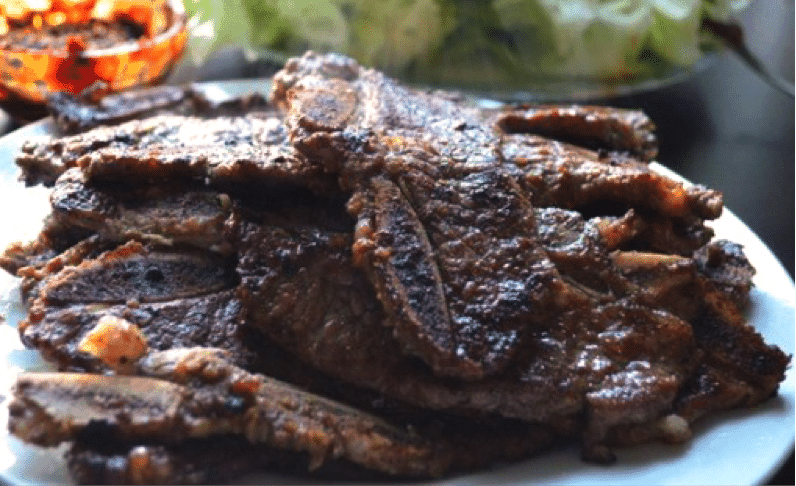
The combination of the sugar, soy sauce, and garlic brings out the subtle flavors of the meat (pork, chicken, or beef) and makes this Korean cuisine a sweet, flavorful, and tender favorite. Galbi is often served with rice and other vegetables. This traditional meal is a crowd-pleaser at Korean BBQ restaurants, and for a good reason!
Bossam (보쌈)
While some of the Korean dishes on this list are intricate and have a long list of ingredients, bossam is a Korean food that is evidence that simple can still be tasty when the components are delicious on their own. Bossam is steamed, tender slices of pork belly into small, nearly bite-sized pieces wrapped in crisp lettuce and served with a dab of dip as a finishing touch.
The wrapping and dipping combine the different textures of the lettuce and the steamed pork slices of pork belly that really take this dish to the next level and make it a treat. The next time you’re craving a meat-based Korean dish or need some extra protein, have some bossam and leave the table feeling satisfied.
Bulgogi (불고기)
Bulgogi is delicious Korean food that is widely recognized as quintessential to the cuisine. The dish has long been a part of Korea’s culinary history. Millions of people have enjoyed it for thousands of years, so it has definitely stood the test of time!
Bulgogi is a sweet meat that has recently been incorporated into a variety of modern dishes, so it’s easy to find at most restaurants. Grab a bowl of rice and some lettuce for wrapping, and you’re in business. The next time you’re in Korea, make sure you try a bulgogi burger for a modern twist on a classic favorite!
Korean Seafood
If you’re a fan of anything seafood, the dishes below are for you! There are various ways of how they’re cooked under this list. They can be grilled, stir-fried, or served as a soup.
Nakji bokkeum (낙지볶음)
Do you like to take a walk on the culinary wild side when you’re dining out? Do you live for trying foods that test your palette and make your eyes water? If so, make sure you add this Nakji bokkeum to your list! Octopus is stir-fried with a medley of extremely spicy ingredients (chili powder and two different types of hot peppers), resulting in a combination that will surely make your mouth water.
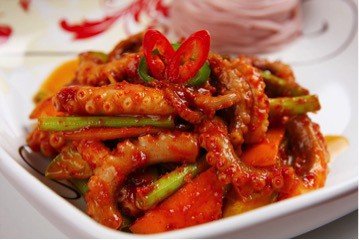
The octopus is seared to the point where it’s tender on the inside, and the sauce is thick and smoky, making the food hard to stay away from. Pair this Korean specialty with gyeranjjim for a well-rounded meal that is packed with flavor – just make sure you’re a fan of spice before doing so!
Grilled clams (조개구이 | jogaegui)
More often than not, the food choices at your favorite Korean BBQ spot will revolve around tender strips of different meats such as pork, chicken, and beef (hence the “barbecue”).
Jogaegui is a fun way to mix it up if you’re looking for something a little different! Shellfish is cooked over an open flame until it’s hot and ready for you to dig into – the shells crack open on their own, adding an extra flair to this Korean favorite.
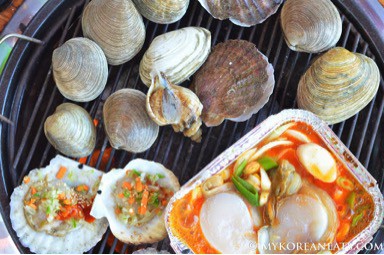
Jogaegui is especially good if you can get it fresh from the ocean because what beats fresh shellfish that fishermen caught earlier that day? If you visit South Korea, give this Korean food a try to incorporate some saltwater fun into your meal the next time you need a break from meat!
Jangeogui (장어구이)
If you’re an adventurous eater, jangeogui is the dish for you! Jangeogui, or grilled eel, is a popular snack rich in vitamins and minerals that will keep your body ready for anything. Although the idea of eating eel is a little intimidating if you haven’t done it before, the flavor is intensely delicious and can’t be found in other dishes!
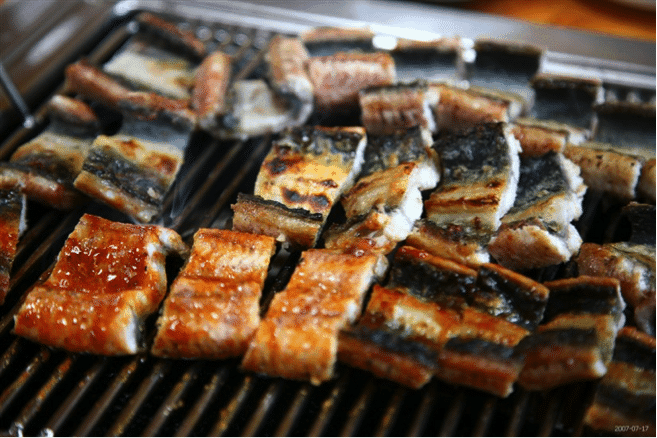
The texture is also great — it’s a little bit tougher than fish, but when grilled, it becomes tender on the inside and develops a nice sear outside. Put your fears aside and try some jangeogui the next time your friends grill it up for dinner. You won’t regret it!
Mulhui (물회)
What’s better than sashimi, you ask? A chilled soup is full of spicy sashimi on a hot summer day! The recipe will vary from restaurant to restaurant because all different types of seafood can be used to give this dish flavor, but it’ll always be cold, a delight for your tastebuds, and perfect for the scorching Korean summer months.
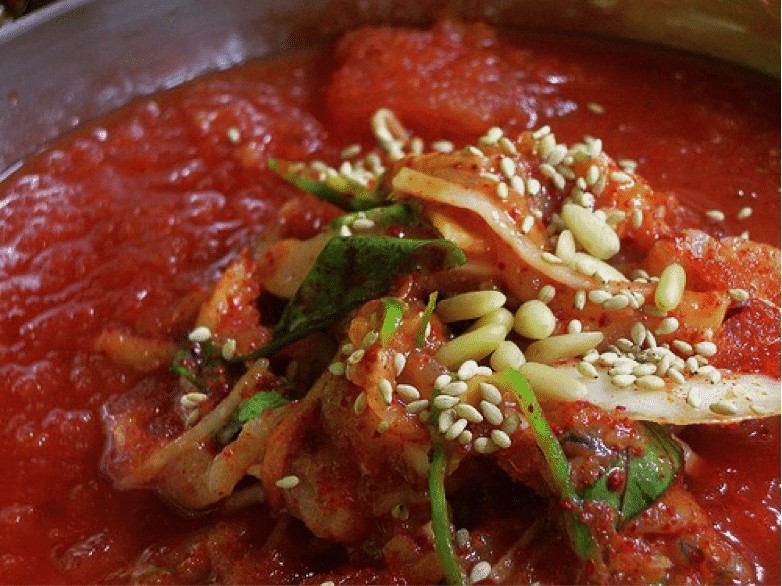
Between the protein in the seafood and the spices’ kick in the sauce, mulhui is a great dish to have in the middle of a long day of fun and exploration in Korea.
If you’re out and about checking out Seoul or the Korean countryside, eating a chilled dish like mulhui will cool you down and keep you from overheating. The protein and vitamins in the dish will make sure you have the fuel that you need to keep going and crossing things off of your to-do list.
Korean Street Food
Apart from the scrumptious food that you can buy at restaurants, South Korea also offers a wide variety of street foods that are definitely worth trying. Street food can be sold in food carts, food trucks, or mobile tents. Just look for them lining up along busy streets and night markets.
Some of the popular street foods are tteokbokki, hotteok, and goldfish bread or bungeoppang. The list for Korean street food goes on! If you’d like to know more about these, we have a separate article dedicated to street food that you can find in Korea.
Korean Desserts
Finally, desserts! During a meal, you can always have room for desserts. The ones that you can find in Korea are worth the space, for sure! Here are some of the best Korean desserts that you can find.
Bingsu (빙수)
If you need something sweet to tie together a rich meal, give bingsu a try for a decadent treat! Bingsu is Korean food in which sweetened red beans and tteok (made of rice flour) are laid atop refreshing freshly shaved ice.
There are many different variations depending on your preferences – condensed milk, fruit, and corn flakes can be incorporated for different flavor and texture combinations.
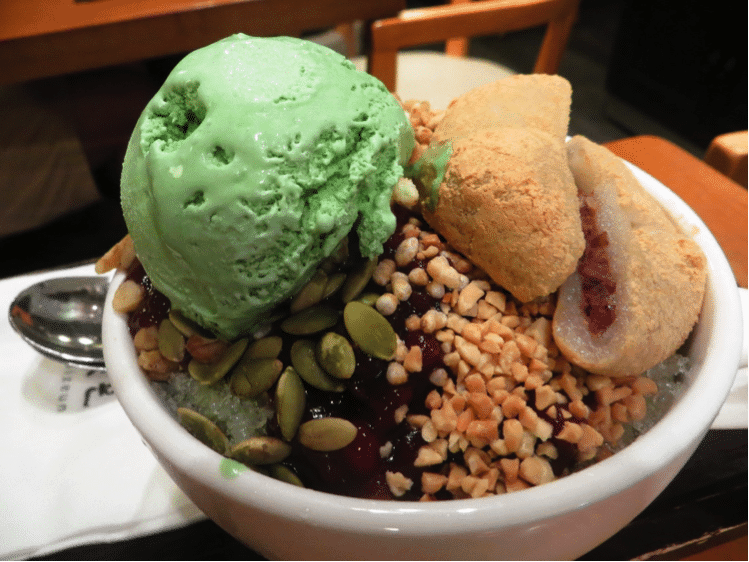
This Korean food can be as simple or as complicated as you’d like, so feel free to mix and match flavors until you find your favorite. Bingsu is everywhere – be sure to give it a try during the summer months for a sweet end to an otherwise delicious meal!
Korean Ice Cream (아이스크림)
Korean ice cream is both similar and different from ice cream in Western countries. It’s found in convenience stores and grocery stores alike, so you should have no problem locating some frozen tasty treats when you need to cool down. However, some types of Korean ice cream are like nothing you’ve ever seen before!
Take Samanco, for example – Samanco is a fish-shaped waffle treat with vanilla ice cream and red bean paste sandwiched in the middle (yes, you read that right). Step outside of your comfort zone and give some of the more unique Korean ice cream desserts a try!
They’re super inexpensive at most shops, so your ice cream adventure won’t break the bank. Some of these snacks are very difficult to find outside of Korea, so if you have the opportunity to try them, you absolutely should!
Wrap up
Korean cuisine incorporates different flavors, textures, and combinations that many cuisines steer away from. As a result, many authentic Korean dishes are likely different from anything you’ve experienced for. Try some dishes from our list to give you a taste of some of the most popular flavors in Korea – and keep experimenting!
We’ve barely scratched the surface of the variety of dishes available in Korea and throughout the world. If this has motivated you to learn Korean, speak Korean, or expand your vocabulary, then we’ve got plenty of great resources for you.
We even have a structured program that can get you to have a 3-minute conversation in Korean in the first 90 Days! Check out our 90 Day Korean Membership program here.
Looking for something a little more daring? Then why not try some of Korea’s more unusual dishes?
You can also check out our article on spicy Korean Street food to try if you’re looking for fiery hot dishes.
Have you tried any of the dishes on this list? If so, what’s your favorite? Let us know in the comments below!

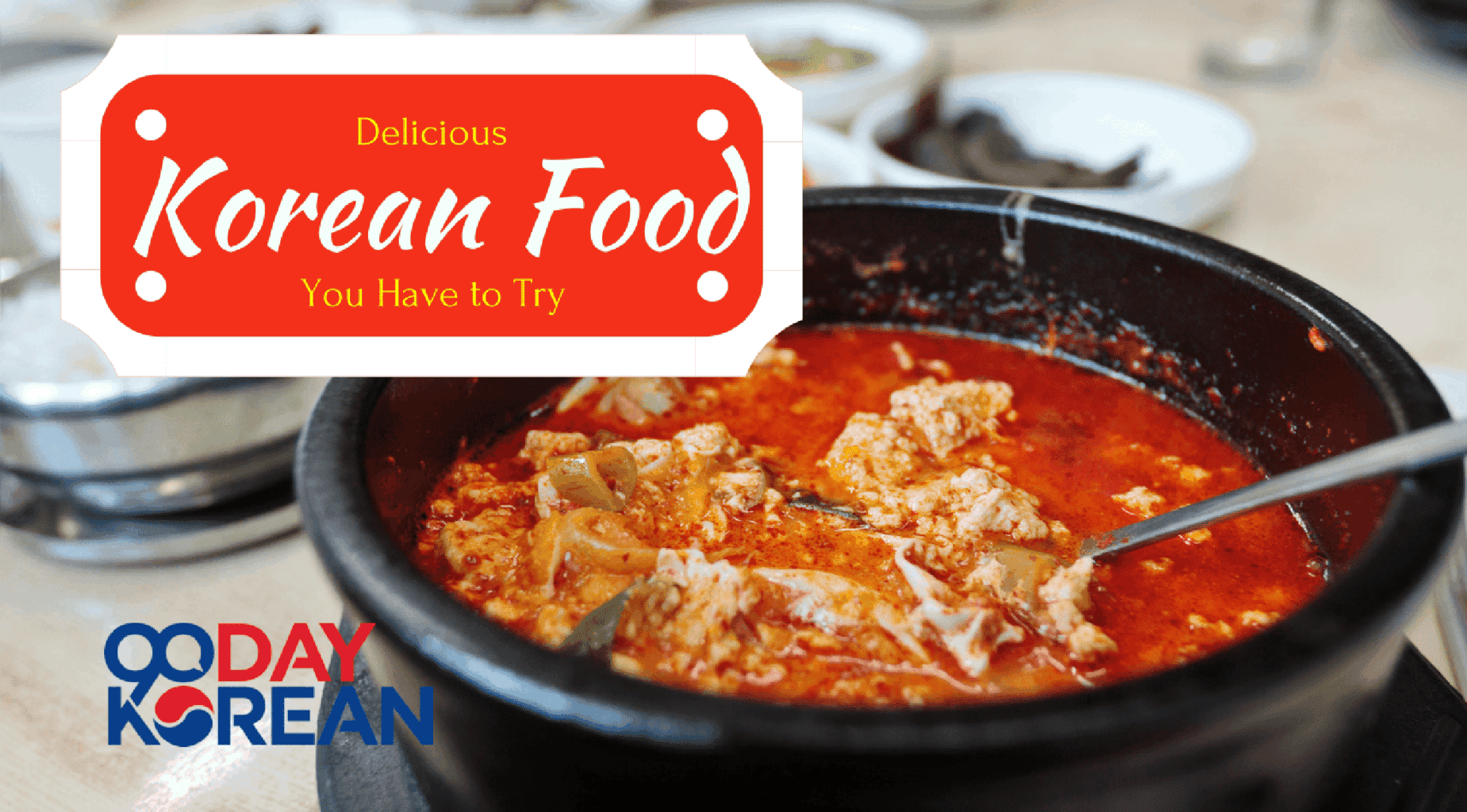
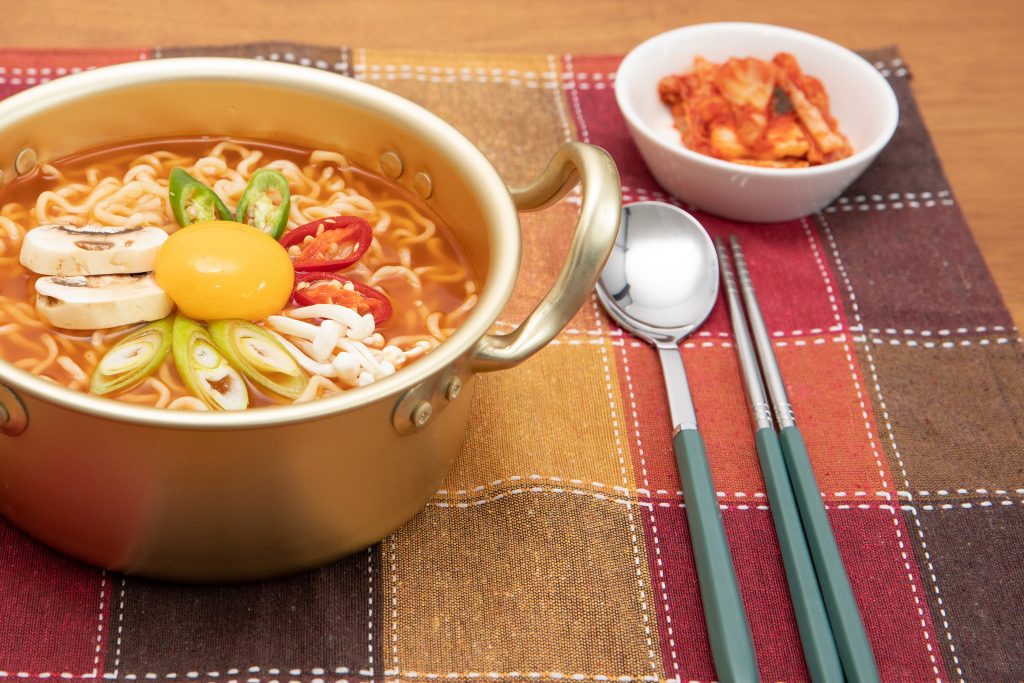
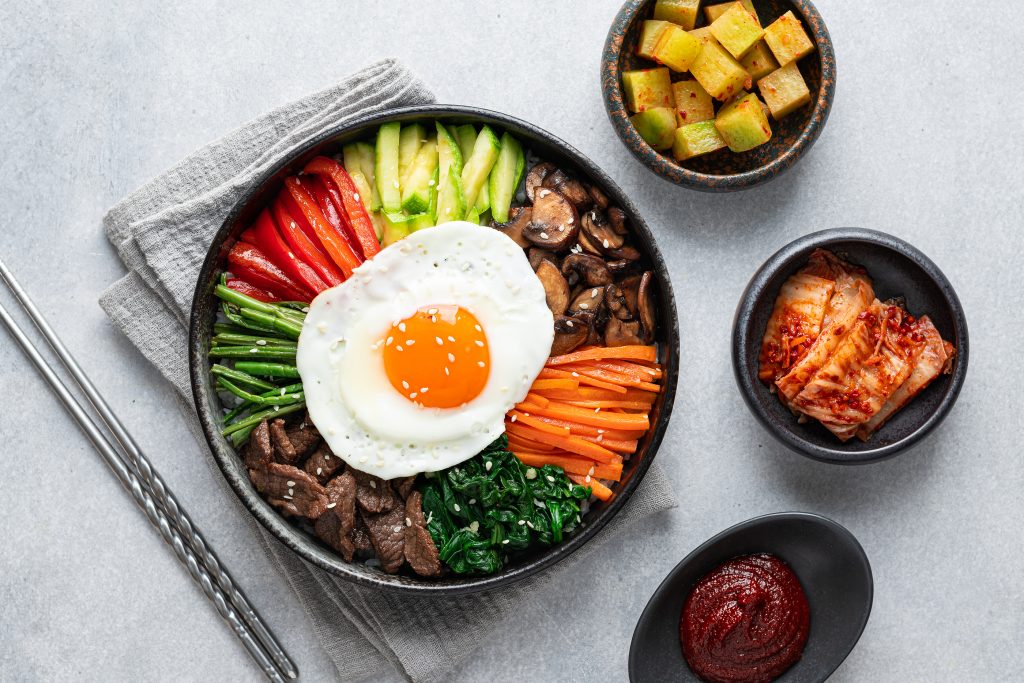

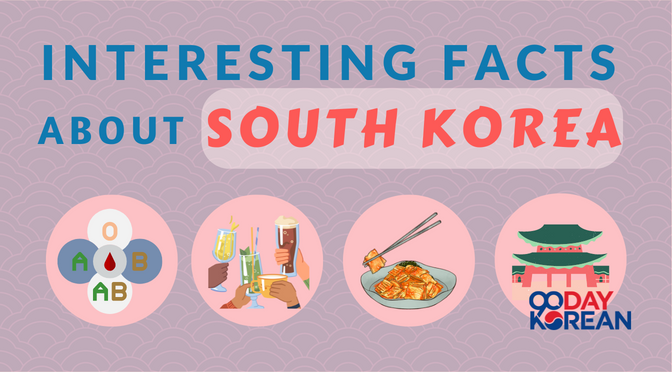


i tried most of them and they never disappoint
id to the try army stew
Awesome, thanks for the comment. You can also check this article if you want to learn about spicy Korean food. https://www.90daykorean.com/spicy-korean-food/
I’ve tried most of these dishes and I can tell you for me Korean food is the best including their bbq. I’ve visited Asia in many occasions but can’t wait to visit Korea ❤️
OMG!!!!!!Korean foods are just soo amazing!!!!!I’m in love with them and I cant wait to go to SEOUL,SOUTH KOREA and have these foods. seeing them itself is making my mouth water, at least I must try to cook them, and thanks for the information, it helped a lot and learned a lot about KOREA’s food
THANK YOU!!!!!
KAMSAHABNIDA!!!!
Thanks for your passionate comment, Da-Eun! ^^
So agree with you ..loveee their food
Am loving Korean food,have tried making kimchi lately, love it…
Great work, Carmelita! How does your kimchi taste? ^^